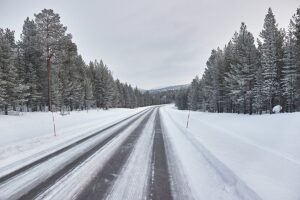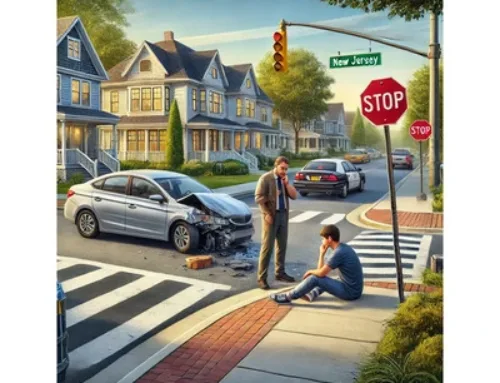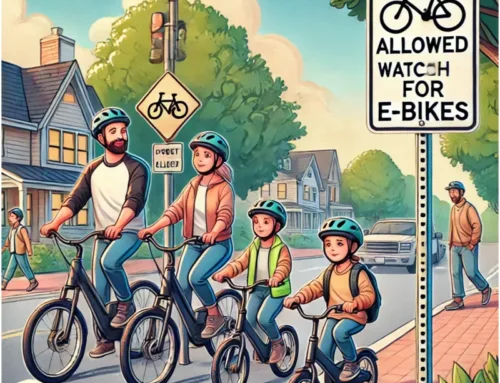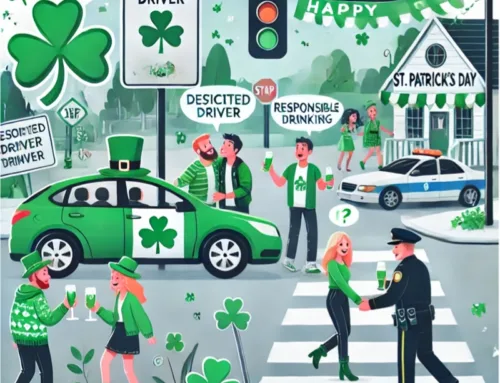As residents of the Northeast are well aware, driving in winter poses a particular set of hazards for motorists. However, with proper planning, vehicle maintenance, and an understanding of how to respond to dangerous road conditions, your winter travels are more likely to remain safe and uneventful.
Advance Preparation:

Driving on snowy winter roads of Finnish Lapland, arctic landsape, icy asphalt
Stay current on vehicle maintenance. Keeping on top of your car’s basic maintenance is always important, but winter conditions can exacerbate existing problems and definitely raise the stakes of being stranded and waiting for help. Whenever possible, try to schedule routine vehicle maintenance to happen before long trips.
Keep your gas tank full. Try to avoid allowing your gas gauge to dip below half a tank. Having plenty of gas in the tank keeps you prepared for unexpected complications like traffic jams or getting stuck in snow, and it also provides less space for moisture condensation inside the gas tank.
Maintain tire pressure and monitor tread wear. Proper traction is vital for successful maneuvering in wintry conditions. Remember that cold weather can lower tire pressure, so make a habit of checking your tire pressure monthly and add air as needed. Tire tread depth should be at least 1/8 inch and can be measured using a quarter: turn the coin upside down, heads-side toward you, and insert it into the tread groove. If you can see the top of Washington’s head, it’s time for new tires. Similarly, be alert for signs of uneven wear, which can indicate alignment or suspension problems.
Maneuvering in Slippery Conditions:
Accelerate from zero slowly. This will reduce tire spinning if you’re parked or stopped on a slippery surface. For vehicles with manual or gear-selectable transmissions, it’s recommended to start in second gear.
Reduce speed to maintain more control. When you feel your wheels start to lose traction, it’s easier to respond to correct the situation if you’re traveling more slowly. Your vehicle will also have less momentum in a slide when traveling at lower speeds, and if a collision is unavoidable, the resulting impact will have less force behind it, inflicting less damage and lowering the risk of injury.
Increase your expected braking distance. You’ll need to brake more gently under slippery conditions in order to maintain traction with the road. As much as double the braking distance needed under normal conditions may be necessary, so increase your following distance between vehicles accordingly. If you drive an older vehicle without ABS (anti-lock braking system), you need to take extra care to prevent your wheels from locking, which can trigger a skid. To prevent this, apply brakes gently with a pulsing, repeating rhythm. Newer cars with ABS do this automatically, and the driver need only apply the brake smoothly and hold it down.
Change your speed, then turn. Trying to accelerate or brake during a turn reduces your control over the vehicle, increasing your chances of skidding in slippery conditions. Any other sudden maneuvers or changes during a turn can have the same effect. Try to avoid sharp steering wheel movements, hard braking, shifting gears, or rapid shifts of weight inside the vehicle (such as from passengers or cargo) during turns.
Know how to correct when your vehicle slides. When you notice the back of your vehicle start to drift or slide during a turn, gently back off the accelerator and turn the steering wheel in the direction that the car is sliding. Don’t over-correct; if you’re trying to make a turn and your vehicle keeps moving straight, avoid the temptation to wrench the wheel harder into the turn. Straighten out the wheel for a second and try to regain traction before attempting the turn again.
Pitfalls to Avoid:
Bridges freeze first. Even if most of the roads are fairly safe, any bridge, overpass, or elevated ramp that is not insulated by the ground is going to freeze before any other stretch of pavement. Take extra care on these areas.
4WD and AWD don’t help as much as you think. These features provide extra traction only when accelerating, which is in many ways the least essential element of winter driving safety. They provide no added benefit for turning or braking.
Watch out for other drivers. You can and should adjust your own driving patterns to account for slippery conditions, but unfortunately you have no power over other motorists. All you can do is leave them extra space on the road and stay alert. Avoid distractions, make your intentions obvious by clearly signaling your turns and lane changes, and pull over to let anyone who is in more of a hurry than you pass by.
Do not pass snow plows. Let them do their job to make the road safer. Give them space, to avoid any pebbles in your windshield from the sanding, and don’t attempt any risky maneuvers to get ahead of them – that’s where all the snow is anyway.
Contact MyNJInjuryLawyer Howard P. Lesnik
If you or a loved one suffered an injury in an accident in NJ, you should contact an attorney familiar with handling these claims. An experienced NJ Injury Lawyer will know how to obtain medical records, videos, photographs, experts, locate witnesses and contact the insurance company so you can make a claim for your injuries.
My NJ Injury Lawyer Howard P. Lesnik, Esq. offers complimentary strategy sessions to address any issue or questions you may have for your injury claim in NJ.
Please contact NJ Injury Lawyer Howard Lesnik, Esq., immediately if you were involved in an accident. I personally handle NJ personal injury cases on a regular basis. Please contact me now by email, by phoning 908.264.7701, or by completing the form to the right to schedule your complimentary 30-minute strategy session. Call me direct and I will answer 5 questions that you have about your potential claim.







